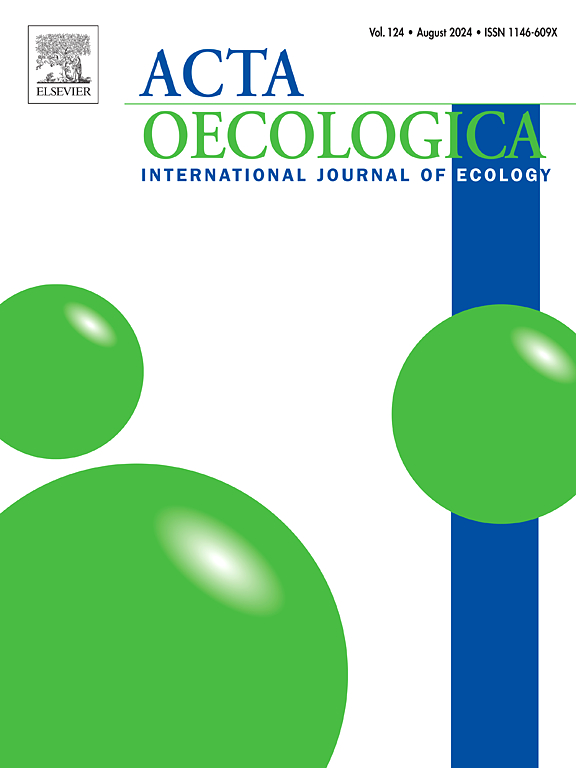外来植物松木和桉树对林地中电解质的毒理学影响。
IF 1.3
4区 环境科学与生态学
Q3 ECOLOGY
Acta Oecologica-International Journal of Ecology
Pub Date : 2025-05-29
DOI:10.1016/j.actao.2025.104085
引用次数: 0
摘要
外来植物的存在与人为活动有关,因为它们具有经济和商业效益。当这些外来物种阻碍了本地物种的发展时,它们就被认为是入侵物种。在巴西,松树和桉树这两种树种尤为突出,它们在生态系统中的存在可能导致化感作用引起的环境失衡。这些入侵物种释放的化感物质可以通过降雨、植物物质分解、根系分泌物和挥发进入环境。这些植物产生的酚类化合物的高溶解度使它们能够到达水体并潜在地影响水生生物。有鉴于此,我们将大水蚤、费氏alivibrio fischeri、斑点兰多丽亚(Landoltia punctata)和芥蓝(lacuca sativa)种子暴露在有外来和原生植被地区的土壤中进行了毒理学评价。样本是近距离收集的,主要区别在于植被覆盖的类型。经过鉴定,发现本地物种覆盖的土壤含有更高水平的有机质和水分,而外来物种覆盖的土壤则显得更干燥。总体而言,毒理学评价表明,原生植被的洗脱液对水生生物D. magna和A. fischeri的毒性作用更大。相反,外来植被的淋洗液中总酚类化合物的浓度较低,但仍对sativa L.种子发育产生毒性作用,并对水生植物L. punctata造成明显的结构破坏。这项研究强调了调查以外来物种为主的再造林地区的重要性,以更好地了解入侵植物对环境的潜在影响。本文章由计算机程序翻译,如有差异,请以英文原文为准。

Toxicological impact of elutriate from wooded soil with the exotic plants Pinus spp. and Eucalyptus spp.
The presence of exotic species of plants in a region is associated with anthropogenic activities due to their economic and commercial benefits. When these exotic species hinder the development of native species, they are considered invasive. In Brazil, two species stand out: Pinus spp. and Eucalyptus spp. Their presence within ecosystems may result in environmental imbalances caused by allelopathy. The allelochemicals released by these invasive species can enter the environment through rainfall, decomposition of plant material, root exudation, and volatilization. The high solubility of phenolic compounds produced by these plants allows them to reach water bodies and potentially affect aquatic organisms. In light of this, a toxicological evaluation was conducted by exposing Daphnia magna, Aliivibrio fischeri, Landoltia punctata, and Lactuca sativa seeds to soil elutriates from areas with exotic and native vegetation. The samples were collected in close proximity, with the primary difference being the type of vegetation cover. Upon characterization, the soil covered by native species was found to contain higher levels of organic matter and moisture, whereas the soil with exotic species appeared drier. Overall, the toxicological evaluation revealed that elutriates from native vegetation induced greater toxic effects on the aquatic organisms D. magna and A. fischeri. Conversely, elutriates from exotic vegetation showed lower concentrations of total phenolic compounds but still exhibited toxic effects on the development of L. sativa seeds and caused notable structural damage to the aquatic macrophyte L. punctata.. This study highlights the importance of investigating reforested areas dominated by exotic species to better understand the potential environmental impacts caused by invasive plants.
求助全文
通过发布文献求助,成功后即可免费获取论文全文。
去求助
来源期刊
CiteScore
3.60
自引率
0.00%
发文量
57
审稿时长
>0 weeks
期刊介绍:
Acta Oecologica is venue for the publication of original research articles in ecology. We encourage studies in all areas of ecology, including ecosystem ecology, community ecology, population ecology, conservation ecology and evolutionary ecology. There is no bias with respect to taxon, biome or geographic area. Both theoretical and empirical papers are welcome, but combinations are particularly sought. Priority is given to papers based on explicitly stated hypotheses. Acta Oecologica also accepts review papers.

 求助内容:
求助内容: 应助结果提醒方式:
应助结果提醒方式:


